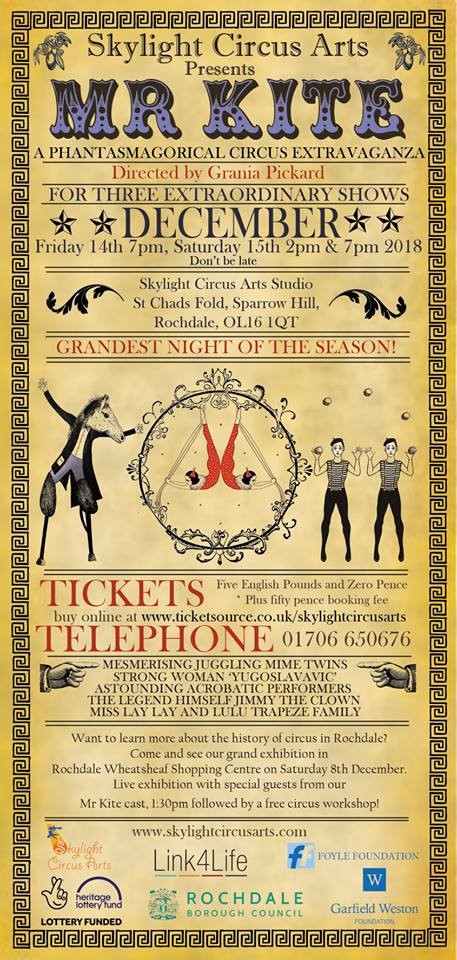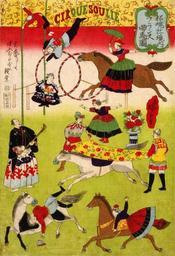CIRCUS SONGS. an aata playlist selection
Track listings
Wild Billy´s Circus Song by Bruce Springsteen
Man On The Flying Trapeze by Dick Powell
Circus Girl by Gretchen Peters
The Wall Of Death by Richard Thompson
Cathy´s Clown by The Everly Brothers
The Tears Of A Clown by Smokey Robinson
Death of a Clown by Dave Davies
Nelly The Elephant by Mandy Miller
Circus by Britney Spears
Being For The Benefit Of Mr. Kite by The Beatles
Those of us of a pensionable age probably look back fondly on a childhood of days in the park, with street cricket, football and games of rounders, whit walks, brass bands, paddling in streams and rambling over open countryside. Given all that, I nevertheless seem to recall that my mates and I occasionally dreamed of running away to join the circus. I had visions, I suppose, of being a hilarious but scary clown, or even worse, a one armed lion tamer, or a remarkable man on the flying trapeze.
The shape of the three ringed circus in the UK has changed considerably since those days and there are now revenue funded arts organisations, like Rochdale’s Skylight Circus, teaching skills that provide a student with transferable talents and confidence to take outside the ‘tent’ into the real world.
Skylight Circus management and staff such as Circus Jim (Riley),´ with all round skills that stretch from acrobatics and clowning to the wild and zany balancing on rolling barrels, are these days synonymous with a town that is proud to house them. Strangely enough, we have a very similar circus organisation here on the island in Haria, which houses an annual festival attracting small circus outfits from all over Europe, and of course, we have just enjoyed the visit from Circuba, The National Circus Of Cuba, as reviewed in an earlier post.
What with John Lennon, Mr. Kite and an old circus poster, the Sidetracks And Detours; Circus playlist would make a great album.
There was a song we used to sing in the North West folk clubs about the annual fair held in nearby Rawtenstall. The lyrics invited us to ‘roll up, roll up and see the tattooed lady’ and other similar delights.
The fair seemed a collection of grotesques, not unlike the travelling medicine shows, fairgrounds and carnivals that once toured America. Circus, too, is often portrayed as a travelling cast of slightly odd characters being blasted out of guns like cannonballs, or standing petrified as knives hurtle into boards surrounding them, or swinging from tiny perch to tiny perch somewhere up in the rafters to the oohs and aahs of the audience below.

Such events have been immortalised in song by American song writers like Joe Ely, Robbie Robertson and Bruce Springsteen. In fact ‘The Boss,’ arguably ring- masters his own three ring circus called the E Street Band.
In his Wild Billy’s Circus Song, that recalled his childhood love, and terror, of the travelling circus, Springsteen had bassist Garry Tallant simulate the elephants’ trumpet, and cleverly closed live performances of the song with the ring-master’s cry of ‘All aboard, Nebraska’s our next stop.’ Indeed it was, as Springsteen released his Nebraska album a few months later.
He not only gave his name to an item of clothing regularly seen in gyms around Rochdale, but he also was the subject of a famous song called The Daring Young Man On The Flying Trapeze. Jules Leotard was never a rope-climbing member of Skylight Circus, perhaps, but he did inspire the song, written in 1867, with lyrics by George Leybourne and music by Gaston Lyle as arranged by Alfred Lee.
Sixty years later the song inspired a short story of the same name, which itself led to a Hollywood film, Man On The Flying Trapeze, starring W.C. Fields. The song was also sung, twice, by Dick Powell, in the nineteen thirties film Twenty Million Sweethearts.
The song has been recorded by a diversity of artists over the years, such as the crooner Eddie Cantor, folk singer Burl Ives, Bing Crosby and Bruce Springsteen. The song has also occasionally provided musical support for cartoon films, as when it was the basis of the 1934 Popeye The Sailor musical cartoon The Man On The Flying Trapezeand, as recently as 1994, Walt Disney’s in house music team re-invented the song for a Mickey Mouse dvd called Let’s Go To The Circus.
She is an acclaimed American singer writer most famous, perhaps, for her song Bus To St. Cloud Minnesota which, with apologies to fellow poets Katie Haigh and Gemma Lees, has a much more poetic ring than their, admittedly brilliant, 163 To Middleton.
Gretchen Peters has written hits for the likes of Martina McBride, Etta James, Anne Murray, Shania Twain and Neil Diamond and was inducted into the Nashville Songwriters Hall Of Fame in 2014. However, it’s as a Circus Girl that Gretchen joins our current Sidetracks And Detours; Circus playlist. She used the phrase as the name of a ‘Best Of’ album title track in 2009.
According to the lyric she became a circus girl because ‘I guess I never wanted no ordinary life.’ However, she paints, in a more subdued shade than the bright hues we have used, circus life as a ‘lonely world.´ ‘It ain’t easy being a circus girl.’
She justifies it all, though, in the final verse by saying she climbs that ladder right up to the sky, without looking down and without asking why, until she seems to stand on top of the world and can believe, just for a moment, ‘I’m a circus girl.’
Most readers will never have seen a motor cyclist ride The Wall of Death and the lyrics of that song are probably more intended to recapture the notion of the travelling American Carnivals of the twentieth century than any ‘circus’ element in England. Nevertheless, like all Richard Thompson songs, the words work on several levels.
The song is a very obvious description of the oval, wooden circuits that motorcycle riders would climb until they were in such a terrifying position that death seemed inescapable. On the other hand, of course, the song works as a metaphor about risk-taking being the very adrenalin of life, and that, in asking his love to come riding on The Wall Of Death, Thompson is in fact proposing a partnership that would be a life of adventure.
Europe’s trick uni-cyclists, like America’s riders of The Wall Of Death, were employed to draw in the crowds.
Thompson´s song was recorded by American Nanci Griffith, on her album Other Voices Too, A Trip Back To Bountiful, on which she also covered Who Knows Where The Time Goes, by Sandy Denny, who worked alongside Thompson for a while in Fairport Convention.
Of course, we should never contemplate a playlist about Circus without any songs that reference clowns, whether happy, sad, or scary.
The first time we heard the song over the radio, we lads who had ever been jilted, knew that when the singer(s) harmonised the line ‘I don’t want your love anymore,’ The Everly Brothers were simply putting on a brave face.
We knew more about unrequited love even than we did about who played what instruments on our favourite songs, but Cathy’s Clown included players who went on to become legendary country music session men.
Floyd Cramer played on piano, Floyd Chance on bass and Buddy Harman, alone, on drums. We emphasise that he was alone because technological loops of wizardry in the studio made the dense percussion sound like two drummers were playing.
The song spent eight weeks at number one in the USA, and is thought to have inspired the way The Beatles delivered Please Please Me several years later.
More than fifty years on, poet, dancer, actress and painter Pam Ashton recorded her own homage to Phil and Don Everly on a recorded compilation, Eight Days In July, of original works by a Touchstones creative writing group.
As we continue with our playlist celebrating circus we reach the part of the show where all the clowns are the ring. We have seen the upside down smile on the brave face of Kathy’s Clown, but Smokey Robinson over there cannot force a smile at all and is, instead, crying the Tears of A Clown.
Clowns, of course, often seem tragi-comic figures with their upside down smile frowns and this song captures in sound what clowns in the ring capture in appearance. The sad lyrics, for a lost love, are set against a very jaunty circus-like music riff, and give the song its memorable hook.
The song was recorded by Smokey with his band The Miracles and on its 1970 release became a big hit, though from 1973 he also enjoyed an illustrious solo career. Smokey Robinson and the Miracles was the first band signed by Tamla Motown.
Another, similarly themed, song that was a huge hit for the musicians was Tracks Of My Tears , though in this song Smokey acknowledged that people would be able to see the real truth behind the forced smile.
In 1987 William “Smokey” Robinson Jr. was inducted into the Rock and Roll Hall of Fame and two years ago was awarded the Library of Congress Gershwin Prize for his lifetime contributions to popular music.
We have already seen clowns in various guises whilst exploring circus through song. We have met Cathy’s Clown and have seen Smokey Robinson shedding the Tears Of A Clown, but there’s another one in the ring now. ´His make-up is dry and it clags on his chin as he’s drowning his sorrows in whisky and gin.´
This one is Dave Davies and he is part of a group who put together a sensational mid-sixties soundtrack to my adolescent youth. Sunny Afternoon, Autumn Almanac, Dead End Street, Dedicated Follower Of Fashion, Waterloo Sunset and Wonderboy, were even followed a few years later by the amazing Come Dancing, and all courtesy of The Kinks. This was a band that included the songwriting talents (and tantrums) of brothers Ray (now Sir Ray) and Dave Davies, and Death Of A Clown was in fact Dave’s debut solo single.
The world weary lyrics were said by Dave to reflect his disillusionment with the demands of touring with the Kinks. It was when his single reached number three in the charts that Dave began to to consider a solo career. However, after subsequent singles met with less success, the idea was set aside until his debut album in 1980.

I wonder how many readers of thereabouts pensionable age, especially those who love a novelty song, might know who was Mandy Miller? We offer you a few clues. The song in question was written by Ralph Butler and Peter Hart. Butler also co-wrote Hey Little Hen and Run Rabbit Run but it might help you to remember that this article is one of our series on circus related songs.
This particular number was recorded in 1956 with George Martin producing it, long before he met The Beatles.
In 1982 it was recorded as a punk version by Toy Dolls that became a top five hit over the Christmas of that year, though its quote from Kipling about ‘the road to Mandalay’ was not as easily discernable as on the original.
The lyric tells an unlikely tale, though in March 2012, in Cork, a forty year old female elephant named Baby behaved exactly as described in the song, but became confused in traffic and was soon found and brought under control.
The singer we are discussing was born in England and christened Carmen Isobella, but became known as Mandy Miller and was a child film actress performing with the likes of Alec Guinness and Kenneth More, before recording Nellie The Elephant.
I have been contemplating, whilst compiling this playlist, whether I would ever have really run away to join a circus. Well, had I known Britney Spears might have been there I’d have raced there as fast as my sixty seven old legs would carry me.
In 2008 Britney’s sixth album was released with Circus as its title track and was generally well received by the critics, though production values were given more acclaim than the lyrics. The title track was the third release from the album and climbed to number three in the charts
Most of the lyrics were Britney’s own work as she sought to create a pop-influenced album as she re-united with collaborators she had worked with earlier in her career. Having previously had her work ethic called into question she told the press, whilst in the recording process, that ‘I’m writing every day, right here at this piano in this living room.’
The accompanying video for the single release of Circus portrays Spears as a ring-leader of a circus accompanied by different performers, and features scenes of Spears in different circus settings.
The video received positive reviews from critics, but was criticized for featuring “cruelly trained animals.’ However, these claims were instantly dismissed by her management and Circus won a Best Video award on Fuse TV.
With Skylight Circus, and their multi talented performers, housed in the town the link between Rochdale and Circus remains at least as strong as the link between John Lennon and a poster that inspired a track on The Beatles’ Sergeant Pepper’s Lonely Hearts Club Band´ album.

A piece in the Manchester Evening News by Jakub Qureshi on February 9th 2013 explained how an exhibition that would shortly be shown at the Museum Of Science And Industry in Manchester would reaffirm how one of The Beatles best loved songs was inspired by a Rochdale event.
John Lennon wrote Being For The Benefit of Mr Kite after being inspired by a vintage poster about 19th century showman Pablo Fanque. The circus master, Britain’s first black big top boss, staged an 1843 show in Rochdale featuring renowned acrobat William Kite, who was also depicted on the advertisement.
While recording the Sgt Pepper album, John Lennon stumbled across a vintage poster for the Rochdale show in an antique shop, which featured the legend ‘For the Benefit of Mr Kite’.
Lennon later told an interviewer: ´The whole song is from a Victorian poster, which I bought in a junk shop. It is so cosmically beautiful.´




Leave a Reply
Want to join the discussion?Feel free to contribute!